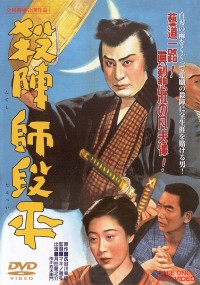 It was exactly 65 years ago today on August 26, 1950 that Fencing Master, a film directed by Masahiro Makino from a screenplay by Akira Kurosawa, premiered in Japan. Released only a day after Kurosawa’s own Rashomon, it was in fact already the fifth (and final) film written or co-written by Kurosawa to premiere in 1950. The other three Kurosawa penned films released in 1950 were Senkichi Taniguchi’s Escape at Dawn, Kurosawa’s own Scandal, and Isamu Kosugi’s Tetsu of Jilba.
It was exactly 65 years ago today on August 26, 1950 that Fencing Master, a film directed by Masahiro Makino from a screenplay by Akira Kurosawa, premiered in Japan. Released only a day after Kurosawa’s own Rashomon, it was in fact already the fifth (and final) film written or co-written by Kurosawa to premiere in 1950. The other three Kurosawa penned films released in 1950 were Senkichi Taniguchi’s Escape at Dawn, Kurosawa’s own Scandal, and Isamu Kosugi’s Tetsu of Jilba.
Kurosawa adapted Fencing Master (Tateshi Danpei) from a play of the same name, written by Kōen Hasegawa (1904-1977) and produced by the Shinkokugeki theatre group for a premiere in March 1949. Kurosawa wrote the screenplay on his own, reportedly facing some problems from the American Occupation censors who required the screenplay to be resubmitted twice before allowing it to be filmed.
The story, set in the late 1910s, centres on the titular Danpei Tateshi, a very typical Kurosawa hero in as much as he is headstrong, somewhat childlike and so concentrated on what he does that he fails to pay proper attention to the people close to him. Although called a fencing master, he is actually not working a martial arts instructor but a theatre choreographer who has made a name for himself by arranging swordfighting scenes. As he is getting older, he is finding himself out of demand with his formal style at a time when the tastes of directors and audiences are changing and calling for a more realistic and graphic approach to fighting scenes. Not only is the fencing master finding it difficult to adjust to these new requirements, but he is literally unable to grasp the meaning of the foreign term realism or understand what is meant by the “graphicality” of performance. The story is significant in being an early example of a concept that Kurosawa injected partly into Rashomon and would four years later explore more thoroughly in Seven Samurai: that of realism in the depiction of the chanbara (samurai film) genre.
Kurosawa’s screenplay was filmed again in 1962, this time by Harumi Mizuho and in colour. While the original 1950 version has, to the best of my knowledge, never been made commercially available with English subtitles, the 1962 remake was released on DVD in 2007 by the Australian Madman Entertainment as part of their Kurosawa DVD set.
In 1955, Masahiro Makino directed what appears to be a sequel to Fencing Master, titled Such Is Life in English (Jinsei tombo gaeri in Japanese). The original play was also adapted for television twice, first in 1962 and then again in 1964, this time with the screnplay written by the original playwright Kōen Hasegawa himself.
For a full list of films that Kurosawa wrote, edited or co-directed for others, see here.






August, 1950: what a time to be a Kurosawa fan! As we have seen, three new stories by Kurosawa get released in the span of just two weeks: Tetsu of Jilba, Rashomon and Fencing Master. One of these would become one of the most celebrated films of all time. Stunning.
I would love to read a contemporary filmgoer’s account of all this. There must, after all, have been people eagerly awaiting for this month when these films were first announced. And if they are anything like me, these people would have been feeling deflated after today, as I so often do after getting through something that I have been eagerly looking forward to for a while.
Fortunately the wait for the next ones wouldn’t be too long: the Kurosawa and Senkichi Taniguchi penned Beyond Love and Hate (directed by Taniguchi and starring Toshirō Mifune) would come out in January 1951, and Kurosawa’s own The Idiot would be released in May. And in June that same year you could also go to see Tatsuyasu Osone’s The Den of Beasts, again filmed from a screenplay by Kurosawa.
This was a time when Kurosawa was everywhere. I count no less than 13 films with Kurosawa’s input between March 1949 (The Quiet Duel) and June 1951 (The Den of Beasts), a time period of just a little over two years.